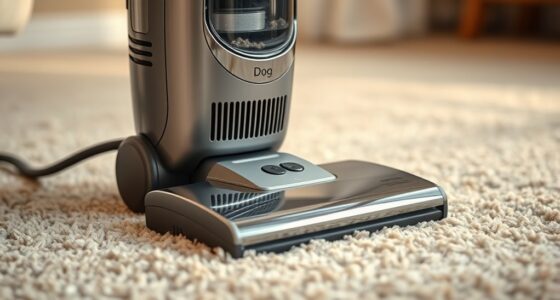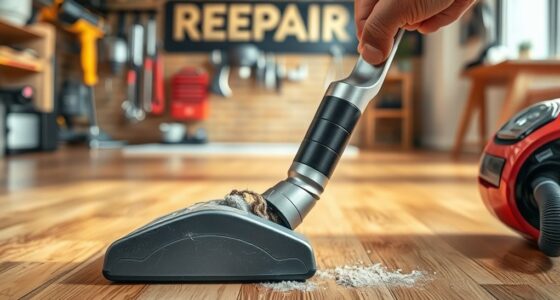To keep your filters working efficiently, wash foam filters regularly with warm water and gentle detergent, replacing them if they become torn or worn. Check if your cartridge filters are washable—if so, rinse and dry them thoroughly; if not, replace every 3-6 months. HEPA filters generally need replacing every 6-12 months, as they aren’t washable. Staying on top of these maintenance steps can improve your indoor air quality—more tips lie ahead.
Key Takeaways
- Wash foam filters with warm water and gentle detergent; replace if torn or excessively worn.
- Check manufacturer instructions for washing or replacing cartridge filters every 3-6 months.
- HEPA filters are typically non-washable; replace every 6-12 months for optimal performance.
- Regularly inspect all filters for dirt, damage, or performance decline to determine maintenance needs.
- Proper maintenance extends filter lifespan, improves air quality, and ensures system efficiency.

When it comes to maintaining your appliances or HVAC systems, knowing whether to wash or replace filters can save you time and money. Proper filter care directly impacts your indoor air quality, helping you breathe cleaner air and reducing dust, allergens, and pollutants. To make the right choice, you need to understand the different types of filters—foam, cartridge, and HEPA—and their specific maintenance needs.
Proper filter maintenance improves air quality and saves money—know when to wash or replace foam, cartridge, and HEPA filters.
Foam filters are typically used in humidifiers, air purifiers, or some HVAC units. They’re usually washable and reusable, making them a cost-effective option if cleaned regularly. When washing foam filters, use warm water and a gentle detergent to remove dirt and debris. Rinse thoroughly and let the filter dry completely before reinstalling. This maintenance tip ensures the filter maintains its shape and effectiveness, preserving your air quality over time. However, if the foam becomes torn or too worn out despite cleaning, replacing it is the best choice to guarantee proper airflow and filtration.
Cartridge filters are common in air purifiers and HVAC systems. Some are washable, but many are designed for one-time use. The key is to check the manufacturer’s instructions. If washable, wash them gently with water and allow them to dry fully to prevent mold growth. If they’re non-washable, replacing them on a regular schedule—every three to six months—is essential for maintaining good air quality. Neglecting this can lead to clogged filters, reduced airflow, and dust or allergens circulating in your home. Regular maintenance tips include keeping an eye on filter condition and replacing when you notice visible dirt or a decline in system performance.
HEPA filters are highly efficient filters used in air purifiers, vacuum cleaners, and some HVAC systems. Most HEPA filters are not washable, as washing can damage the dense fiber network, reducing their effectiveness. Instead, these filters should be replaced according to the manufacturer’s recommended schedule—usually every 6 to 12 months. Some HEPA filters come with pre-filters that can be washed or vacuumed to extend their lifespan, but the main HEPA element needs replacement. Proper care of HEPA filters is vital for maintaining excellent air quality, especially if you or your family members suffer from allergies or respiratory issues.
Additionally, understanding filter lifespan and replacement schedules can help you maintain optimal indoor air quality and system efficiency over time.
Frequently Asked Questions
How Often Should I Replace My HEPA Filter?
You should replace your HEPA filter every 12 to 18 months to guarantee ideal air purifier lifespan and filter material longevity. Regularly check the filter for dirt buildup or decreased performance, as factors like air quality and usage can affect replacement timing. By replacing it on schedule, you maintain clean air and keep your device working efficiently, preventing strain on the motor and ensuring continuous air purification.
Can I Wash a Carbon Filter Safely?
Think of your carbon filter as a delicate sponge that gently absorbs impurities. You can, with care, attempt carbon cleaning, but it’s not always foolproof. Washing might extend the filter’s lifespan temporarily, yet it risks damaging its ability to absorb odors effectively. For peak performance, keep an eye on signs of wear and replace the filter when needed, ensuring your device continues to breathe fresh, clean air.
What Are Signs My Filter Needs Replacement?
You should replace your filter when it shows signs of reduced airflow, persistent odors, or visible dirt buildup, indicating it’s past its filter lifespan. Regular maintenance frequency helps prevent issues, but if cleaning no longer restores performance, a replacement is necessary. Don’t wait too long, as a clogged filter can strain your system and diminish air quality. Trust your senses and follow manufacturer recommendations for ideal filter maintenance.
Are There Eco-Friendly Filter Disposal Options?
Did you know over 300 million filters end up in landfills annually? To reduce this, you should explore eco disposal options like biodegradable filters or recycling programs. These environmentally friendly choices break down naturally, minimizing pollution. By choosing biodegradable filters and proper disposal methods, you help protect our planet while maintaining clean indoor air. Always check with manufacturers for eco disposal options to guarantee you’re making a sustainable impact.
Do All Filters Require the Same Maintenance?
No, all filters don’t require the same maintenance. Each type has a different lifespan and specific maintenance tips. Foam filters may need regular washing, while cartridge filters often need replacement, and HEPA filters typically require careful handling or replacement when saturated. Check your filter’s instructions to guarantee ideal performance and longevity, and perform routine maintenance to extend their lifespan and keep your air clean.
Conclusion
To keep your air feeling crisp and inviting, think of your filters as gentle guardians that need some tender care. Whether you choose to wash or replace them, you’re giving your home a quiet hug of renewal. Just like tending to a delicate garden, a little attention now ensures your air stays pure and vibrant. With each thoughtful step, you’re creating a cozy haven where every breath feels like a revitalizing breeze.









